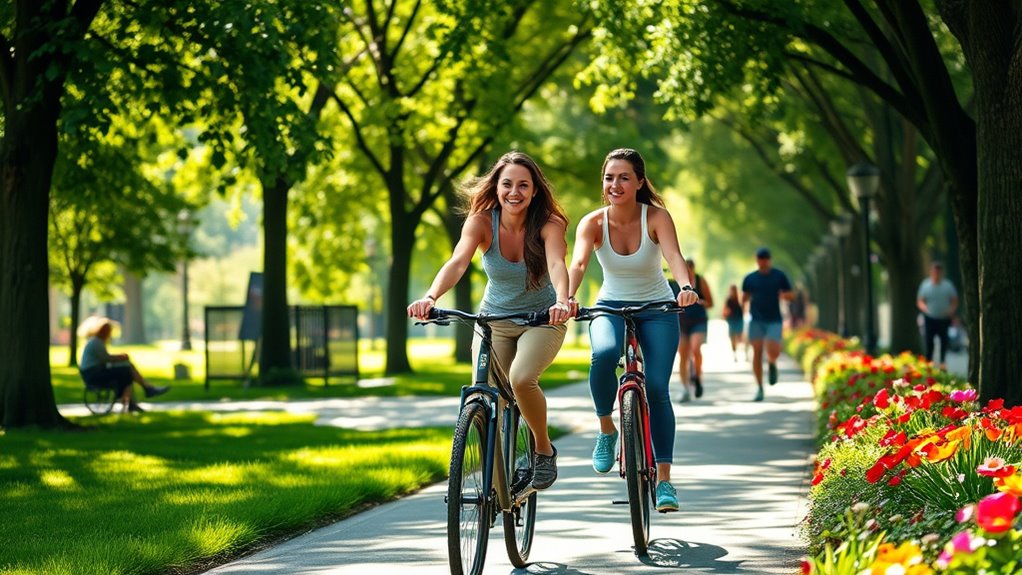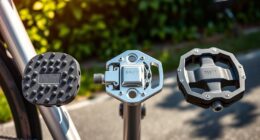To make biking part of your daily routine, start by choosing a comfortable bike that fits well and safety gear like a helmet and lights. Begin with short, manageable rides in safe environments, gradually increasing your distance as you build confidence. Incorporate cycling into errands or commutes to keep it consistent, and track your progress to stay motivated. Keep at it, and you’ll soon enjoy biking as a natural, enjoyable part of your day—there’s more to discover that can help you succeed.
Key Takeaways
- Incorporate cycling into daily errands or commutes to establish a consistent routine.
- Start with short, manageable rides to build confidence and gradually increase duration and frequency.
- Track your progress and celebrate milestones to stay motivated and committed.
- Choose familiar, safe routes to make riding feel comfortable and enjoyable.
- Equip yourself with safety gear and proper lighting to feel secure and encourage regular riding.

Are you ready to hit the road on two wheels but unsure where to start? If so, you’ve already taken the first step toward making cycling a regular part of your life. The key to successful integration is planning and consistency. Begin by choosing a comfortable bike that fits your size and riding style. If you’re new to biking, visit a local bike shop to get fitted properly; the right bike makes a huge difference in comfort and safety. Once you have your bike, familiarize yourself with its features—brakes, gears, and tires—so you feel confident handling it.
Next, find a safe, low-traffic area to start practicing. A park or bike path with smooth surfaces can help you build confidence without the pressure of busy streets. Begin with short rides, maybe 10 to 15 minutes, and focus on mastering basic skills like steering, braking, and starting smoothly. Don’t worry about speed or distance at this stage—your goal is to get comfortable on the bike. As your skills improve, gradually extend your riding time and explore different terrains.
Start in safe, low-traffic areas with short rides to build confidence and master basic skills.
Wearing proper safety gear is essential from the start. Always put on a well-fitted helmet, and consider gloves and reflective clothing if you’ll be riding in low-light conditions. Visibility is vital, especially if you plan to ride on roads, so make sure your bike has front and rear lights. Learning how to use these safety features correctly will boost your confidence and keep you safe. Additionally, understanding the importance of visibility and safety gear can further enhance your riding experience and safety.
Planning your routes is another important step. Start with familiar, quiet streets or dedicated bike lanes in your area. Map out your rides in advance, and keep your rides manageable—don’t push yourself too hard at the beginning. Consistency is more important than distance; aim for daily or several times a week, even if each ride is short. Incorporating smart route planning can help you avoid cycling hazards and make your rides more enjoyable. Moreover, integrating cycling into your daily routine by attaching it to errands or commutes can reinforce your habit and make biking an effortless part of your lifestyle. For example, if you have a nearby grocery store, try biking there instead of driving. This helps establish a habit and makes cycling a seamless part of your life.
Being aware of toilet flushing mechanisms and their efficiency can also inspire you to adopt water-saving habits in daily routines, reinforcing the importance of mindful resource use. Additionally, understanding the role of contrast ratio in projectors can motivate you to seek out better lighting conditions for outdoor cycling, especially during early mornings or late evenings. Proper planning and preparation can also help you avoid common cycling hazards and ensure a safer riding experience. Finally, stay motivated by tracking your progress and celebrating small milestones. Whether it’s riding a certain distance without stopping or feeling more comfortable on busy streets, recognizing your achievements keeps you motivated. Remember, every rider started somewhere, and with patience and persistence, cycling will become a natural, enjoyable part of your daily routine.
Frequently Asked Questions
What Is the Ideal Bike Size for Beginners?
The ideal bike size for beginners depends on your height and inseam measurement. You should feel comfortable while sitting on the saddle, with your feet flat on the ground and a slight bend in your knees when pedaling. Generally, a bike with a frame size matching your height guarantees better control and comfort. Make sure to test ride different sizes to find what feels best, boosting your confidence and enjoyment.
How Can I Stay Safe While Cycling Daily?
Imagine riding a bike is like dancing—balance, awareness, and safety matter. To stay safe daily, always wear a helmet, follow traffic laws, and use lights and reflectors. Check your bike regularly for maintenance. For example, I once avoided a pothole because I noticed a squeak, preventing a fall. Staying alert and prepared keeps your ride smooth and safe, so you can enjoy cycling every day without worries.
What Are the Best Routes for New Cyclists?
You should look for routes that have designated bike lanes or trails, which keep you safe from traffic. Avoid busy streets and choose quieter neighborhoods or parks with smooth paths. Use cycling apps or local maps to find beginner-friendly routes nearby. Stick to familiar areas until you gain confidence. Always wear a helmet and stay alert to your surroundings, making your first rides enjoyable and safe.
How Do I Maintain My Bike Regularly?
Like a knight tending to their steed, you should regularly check your bike to keep it in top shape. Clean your chain and frame, lubricate moving parts, and inspect tires for wear or damage. Keep an eye on brake function and gear shifting. Regularly tighten bolts and replace worn components. This routine guarantees smooth rides and prolongs your bike’s lifespan, making every journey safer and more enjoyable.
What Gear Should I Wear for Daily Commuting?
When you’re commuting daily, you should wear comfortable, weather-appropriate gear. Opt for a lightweight helmet for safety, and consider reflective clothing or accessories to stay visible. Wear moisture-wicking clothes to keep dry and comfortable, especially if you encounter rain or sweat. Don’t forget sturdy, closed-toe shoes for pedal grip and protection. A pair of gloves can improve grip and protect your hands, making your ride safer and more enjoyable.
Conclusion
Just like the hero in a classic tale, you’re stepping into a new chapter—one where every pedal stroke brings freedom and energy. Remember, the journey of a thousand miles begins with that first ride. Embrace the wind in your hair and the rhythm of your pedals, knowing you’re carving your own adventure. With each ride, you’re rewriting your story—stronger, healthier, and more alive. So, gear up and let your journey unfold.









